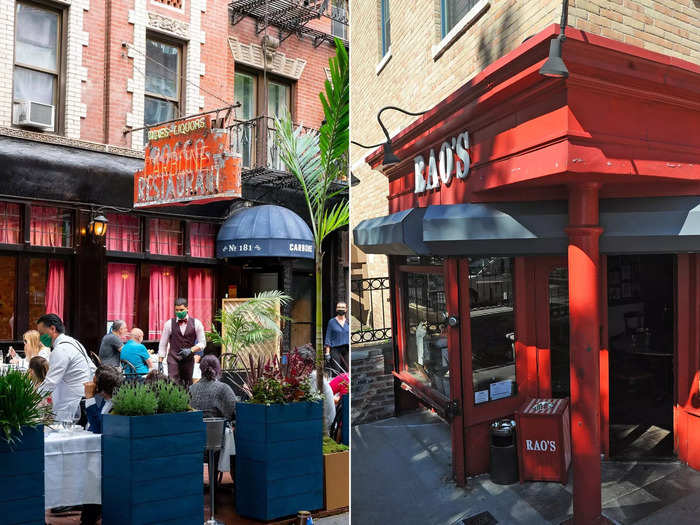
Rao's (left) and Carbone (right) sauces on penne pasta.Rachel Askinasi/Insider

Carbone, the Michelin-starred restaurant by chef Mario Carbone, sits on Thompson St. in Manhattan's West Village neighborhood. The hard-to-get-into Italian restaurant is known for its spicy rigatoni and veal Parmesan dishes, and has become a hotbed for celebrity sightings.
Rao's in East Harlem is known as New York's most exclusive restaurant — you have to know someone with a connection to get a reservation.
Luckily, those of us who haven't been able to dine at either eatery can still get a taste at home with their respective retail sauces.

When I reach for a jar of sauce at the supermarket to replenish my pantry stock, I almost always pick up tomato basil sauce. I think it's multipurpose and versatile while also being more robust in flavor than marinara.
So when it was time to compare these two labels, I thought this variety would be the best and the most wide-reaching.
To keep things consistent, I tasted both sauces at room temperature.

The suggested retail price for a jar of Rao's tomato basil sauce is $8.99, according to a company representative.
While that's not an outrageous price tag, it's still on the higher end of the spectrum (for comparison, this jar of Rao's is $7 more than widely-recognized Ragú sauce). However, sauce is something I'm willing to pay more for when I know I'm getting a tastier product.
That being said, I usually wait until it goes on sale to stock up — I've once gotten a jar for as low as $6.

The first thing I noticed about the Rao's sauce was that it was definitely wet in texture as opposed to paste-like. When I tasted it, I noticed how it felt more like hand-crushed tomatoes instead of a purée because of the inconsistencies of liquid and chunky bits.
I could see tiny specks of basil along with tomato seeds just by looking at the sauce.
It was acidic, but not overwhelmingly so, and it tasted like I could dip fried calamari or mozzarella sticks directly into the jar without doctoring it up at all or heating it. I thought it was delicious and perfect at room temperature.

I noticed how loose this sauce was when I spooned it over my freshly-cooked pasta. While it pooled at the bottom of the bowl, it didn't separate into liquid and tomato chunks, which was a plus.
The sauce coated each noodle nicely, added a tanginess to the flavor of the pasta, and felt like a complete dish while I was eating it. It's simple and delicious.

I started seeing the restaurant's jars pop up on shelves over the past year.
I had never been to the restaurant, and I never saw the sauce on sale from its suggested retail price of $9.99, so I always stuck to buying a sauce I knew I already liked.
But after I made Mario Carbone's meatball recipe at home using Rao's sauce, he mailed me a few jars of his namesake brand to try, and I started with the spicy Arrabbiata.
For this article, I purchased a jar of the Carbone tomato basil sauce, and this was my first time tasting it.

I also noticed a similar oil sheen on this sauce, along with basil flecks and tomato seeds. A visual difference I picked up on was that the Carbone sauce was more orange in color than Rao's, which had a deeper red hue.
This sauce was thicker than Rao's — I noticed that right when I dipped my spoon into the jar — and the texture was more like puréed tomatoes with its pasty consistency.
The flavors here were also acidic but less sweet, which meant it was a little more of a biting acidity that I felt could be mellowed with other dish ingredients.
I could see myself cooking with this sauce from Carbone. I'd use it in an eggplant or chicken parm, a baked pasta dish, or another special recipe I wanted to invest time in. But I don't think I'd use it as-is for dipping.

I thought this sauce gave a slightly better eating experience. It really stuck to each piece of pasta and also remained intact.
In terms of flavors, I thought the Carbone sauce tasted better on pasta than it did when I tried it plain. That made me more confident in my theory that this sauce should be used with intention. I don't think it would suit the needs I have for a pantry-staple sauce, but I would purchase it to use for a special, specific recipe.

Both sauces are delicious, but they are definitely very different in taste and texture. After spending probably too much time thinking about them both, I realized that Rao's sauce reminds me more of a classic red-sauce joint, while Carbone's sauce transports me to a fancy pasta restaurant.
I take my pantry staples seriously, and I need items that are versatile but also reliable. I keep a jar of sauce on hand for things like last-minute pasta nights, but also for fortifying beef stews, making Sunday gravy, and salvaging vegetables that are close to going bad.
The Carbone sauce I tried would not fit those needs. It's too distinct in its flavor, in my opinion. Rao's sauce, however, is more malleable, takes on other flavors well, and boils down nicely. I wouldn't want to alter the Carbone sauce like that.
While I feel Rao's is ready to go at room temperature, I wouldn't dip a mozzarella stick into the jar from Carbone. So if you're looking for an all-purpose sauce to keep in your kitchen, I'd recommend purchasing Rao's. But if you're buying jarred sauce for a pasta recipe or to make a dish like Carbone's meatballs, I'd recommend trying his namesake sauce.
 I spent $2,000 for 7 nights in a 179-square-foot room on one of the world's largest cruise ships. Take a look inside my cabin.
I spent $2,000 for 7 nights in a 179-square-foot room on one of the world's largest cruise ships. Take a look inside my cabin. Saudi Arabia wants China to help fund its struggling $500 billion Neom megaproject. Investors may not be too excited.
Saudi Arabia wants China to help fund its struggling $500 billion Neom megaproject. Investors may not be too excited. Colon cancer rates are rising in young people. If you have two symptoms you should get a colonoscopy, a GI oncologist says.
Colon cancer rates are rising in young people. If you have two symptoms you should get a colonoscopy, a GI oncologist says. India's forex reserves sufficient to cover 11 months of projected imports
India's forex reserves sufficient to cover 11 months of projected imports
 ITC plans to open more hotels overseas: CMD Sanjiv Puri
ITC plans to open more hotels overseas: CMD Sanjiv Puri
 7 Indian dishes that are extremely rich in calcium
7 Indian dishes that are extremely rich in calcium

Copyright © 2024. Times Internet Limited. All rights reserved.For reprint rights. Times Syndication Service.